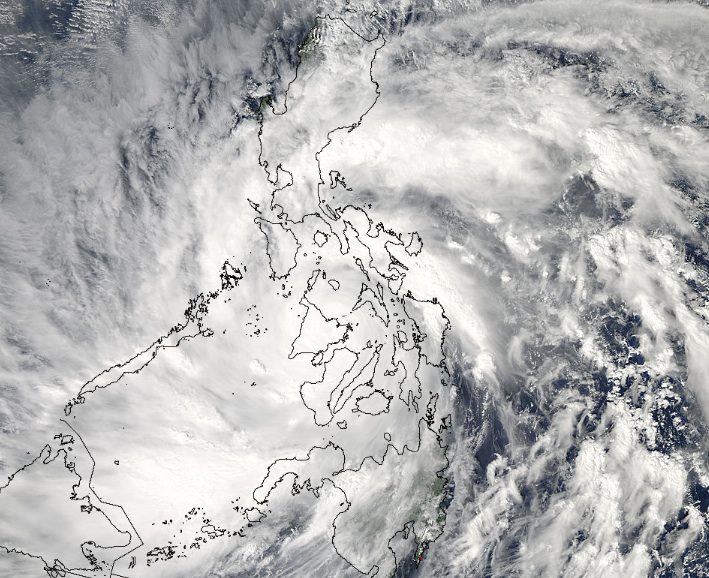moving over the central Philippines, Nov. 8 at 05:10 UTC/12:10 a.m. EDT, as captured by the MODIS instrument aboard NASA’s Aqua satellite. Image Credit: NASA Goddard MODIS Rapid Response Team
By Clarissa Batino, Cecilia Yap and Joel Guinto
Nov. 8 (Bloomberg) — Super Typhoon Haiyan, the year’s most powerful cyclone, slammed into the central Philippines, killing at least four people, cutting power and communication lines and damaging crops.
Two people died after being electrocuted, while one person was hit by lightning, said Major Rey Balido, a spokesman for the National Disaster Risk Reduction and Management Council. A fourth person was reported killed by the Associated Press.
EARLIER COVERAGE: Super Typhoon Haiyan
Seven people were injured and one was missing, according to the nation’s military. The death toll may rise, said Balido. President Benigno Aquino, who appealed for citizens to seek shelter before the storm, ordered all government agencies to conduct search-and-rescue operations.
Haiyan was the strongest tropical cyclone on record to make landfall, said Jeff Masters, founder of Weather Underground in Ann Arbor, Michigan. The Philippines was the nation most affected by natural disasters in 2012, with more than 2,000 deaths, according to the Brussels-based Centre for Research on the Epidemiology of Disasters.
Crop Damage
High winds have swept about half of the Philippine’s sugar cane-growing areas and a third of its rice-producing land, according to Commodity Weather Group LLC in Bethesda, Maryland.
“Winds were so intense in this system that a lot of the crop is just going to be flattened,” said David Streit, an agricultural meteorologist with CWG.
As much as 20 to 35 percent of the rice and sugar in those areas may be damaged, Streit said by telephone.
Haiyan slammed into the eastern province of Samar at 5 a.m., packing winds of 235 kilometers (146 miles) per hour and making landfall four more times since, the weather bureau said. Leyte, Samar and Bohol provinces are without electricity after transmission lines were toppled, the National Grid Corp. of the Philippines said. Parts of Cebu, Negros and Panay as well as Surigao del Norte and Sorsogon also experienced outages.
Storm Winds
Haiyan is “the strongest tropical cyclone on record to make landfall,” said Masters at Weather Underground.
Using average estimates from the Philippine weather bureau and the Joint Typhoon Weather Center, Masters said the storm had winds of between 190 and 195 miles per hour at landfall.
While Manila, the Philippine capital, may not be directly hit by the storm, there may be strong winds and heavy rain, the Metropolitan Manila Development Authority said on Twitter. People are encouraged to remain indoors, it said.
Supreme Court Chief Justice Maria Lourdes Sereno shut the courts in Metro Manila from noon. It was business as usual for other government agencies, Communications Secretary Sonny Coloma said. Financial markets operated today.
Haiyan is moving two times faster than an average cyclone at 40 kilometers an hour, the weather bureau said, forecasting that the super typhoon will move out of the Philippines by 10 a.m. tomorrow. Haiyan is expected to strike Vietnam next, according to the U.S. Navy’s Joint Typhoon Warning Center.
Wind Estimate
The storm had top winds of 166 mph on the scale used by the U.S. to measure tropical systems, which made it equivalent to a Category 5 hurricane, according to the latest Navy statement.
It’s difficult to assess the damage at this point because communication lines are down, Eduardo del Rosario, the head of the disaster-monitoring agency, told reporters in Manila. Communities are more cooperative now about evacuating due to previous disasters, he said.
Typhoon Haiyan’s total economic impact may reach $14 billion, with the insured portion probably almost $2 billion, according to a report by Jonathan Adams, a senior analyst at Bloomberg Industries, citing Kinetic Analysis Corp.
Search Missions
President Aquino “has directed all government agencies to conduct continuous search-and-rescue activities,” Coloma said. One of the priorities would be to restore power and communications, he said.
More than 125,000 people fled their homes and almost 2,000 were stranded in ports, the government said. The Philippines ordered evacuations from Nov. 6, with President Aquino appealing in a nationwide address yesterday for people to move to higher ground and seek safer shelters, warning of serious danger.
Heavy rain from storms usually causes the highest death tolls in the Philippines, Masters said. Flooding may not be the worst threat with Haiyan because of the speed at which it’s moving, he said. Still, high winds and storm surges have the potential to cause catastrophic damage, he said.
Past Storms
Aquino said that Haiyan may cause more damage than Storm Bopha, which killed 1,067 and left 834 missing when that cyclone triggered landslides in Mindanao in 2012. Typhoon Ketsana killed more than 400 when it swamped Manila and parts of Luzon in 2009. Storm Washi killed more than 1,200 people in December 2011.
The strongest tropical cyclone on record was Super Typhoon Nancy in 1961, which had top winds of 215 miles an hour, according to Masters. The strongest storm to hit land was Camille, which went ashore in Mississippi with winds near 195 mph, said Masters.
Inflation will remain within target this year even as the storm may push the costs of some commodities higher, according to Bangko Sentral ng Pilipinas Deputy Governor Diwa Guinigundo. The impact on rice prices may be limited as much has been harvested, he said in a mobile-phone message today.
More than 150 domestic and overseas flights were canceled as of noon, according to the Transportation Department. Ten airports were closed, the aviation authority said. Classes were suspended in 44 cities and municipalities, the government said.
Copyright 2013 Bloomberg.

 Join The Club
Join The Club











